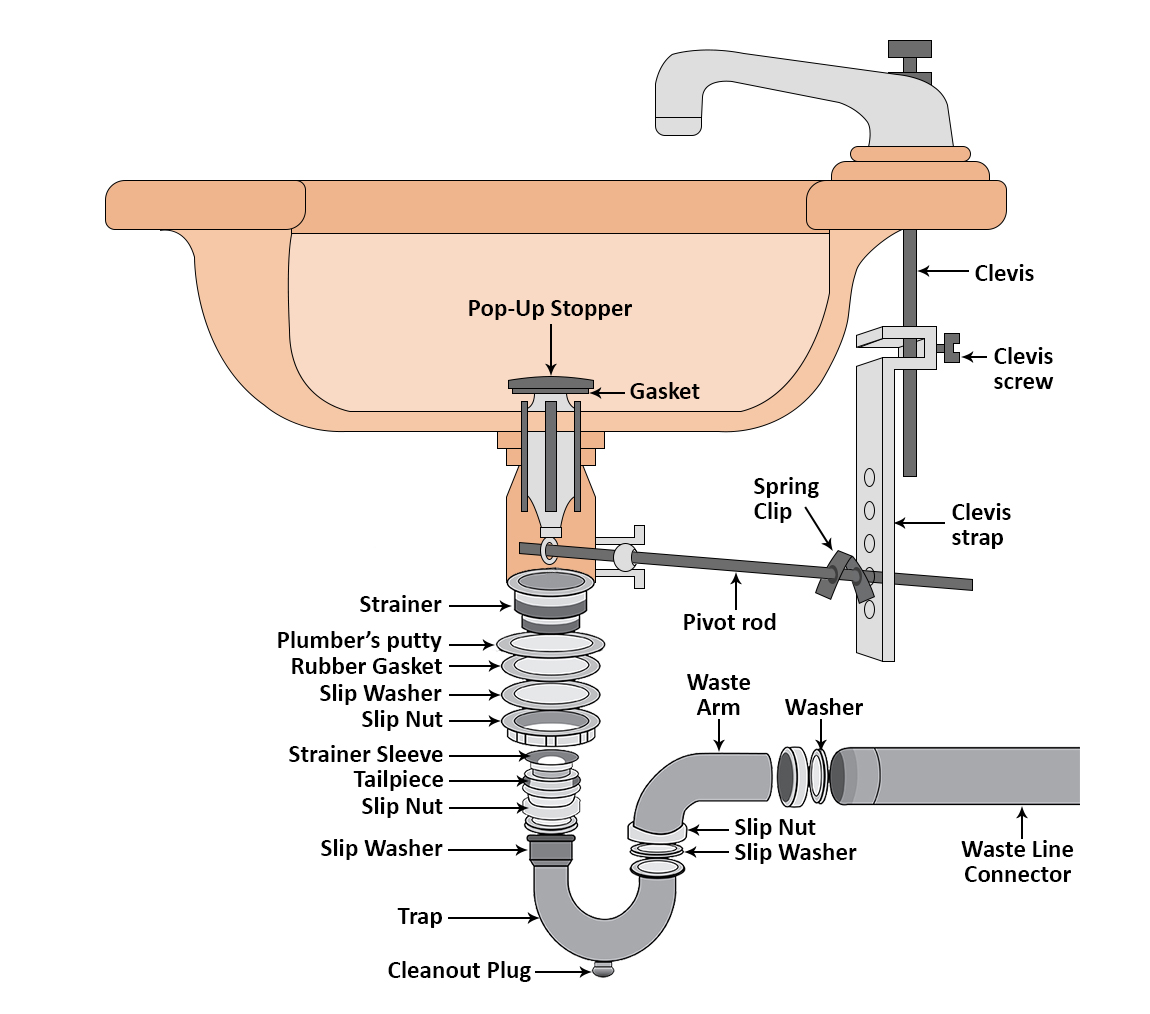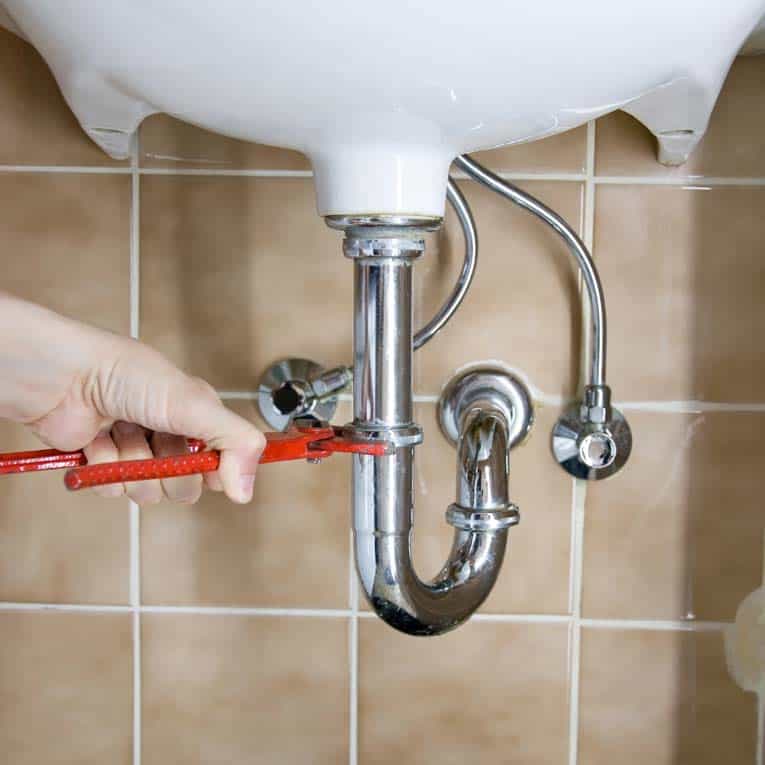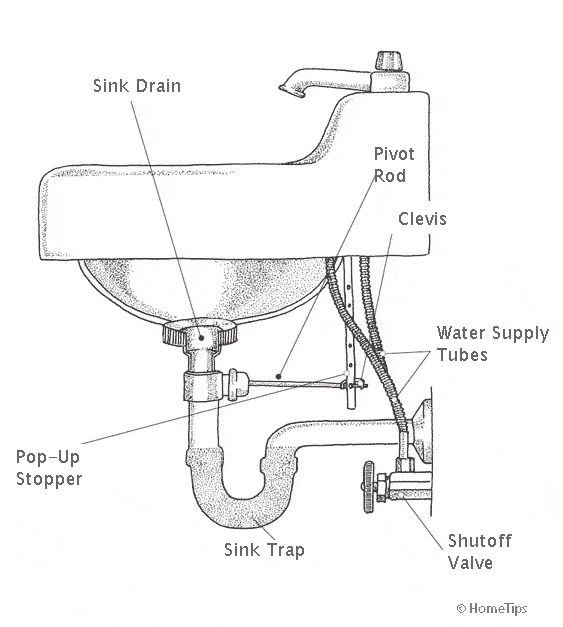The Basics of Bathroom Sink Drain Installation
Installing a bathroom sink drain may seem like a daunting task, but with a little knowledge and the right tools, it can be a straightforward process. Let’s discuss the basics of bathroom sink drain installation, providing you with the necessary information to tackle this project with confidence.
- Understanding the Components: Before diving into the installation process, it’s essential to familiarize yourself with the different components of a bathroom sink drain setup. These include the drain pipe, P-trap, tailpiece, and pop-up assembly. Each component plays a crucial role in ensuring proper drainage and preventing leaks.
- Tools and Materials Needed: To install a bathroom sink drain, you will need a few essential tools and materials. These include a wrench, plumber’s tape, silicone sealant, and a bucket. Additionally, it’s crucial to have the manufacturer’s instructions for your specific sink and drain assembly on hand.
- Preparing the Sink: Before installing the drain, ensure that the sink is clean and free of any debris. Place a towel or cloth over the drain hole to prevent any small parts from falling into it. This step is crucial to ensure a smooth installation process and prevent damage to the sink.
- Assembling the Drain: Start by attaching the tailpiece to the bottom of the sink. Apply the plumber’s tape to the threads to create a watertight seal. Next, connect the P-trap to the tailpiece, making sure to align the trap arm with the waste pipe opening. Use a wrench to tighten the connections, but be cautious not to overtighten and risk damaging the components.
- Checking for Leaks: Once the drain is installed, it’s vital to check for any potential leaks. Fill the sink with water and observe the connections and pipes for any signs of leakage. If you notice any leaks, tighten the connections or apply additional sealant as needed.

Choosing the Right Drain for Your Bathroom Sink
When it comes to choosing a drain for your bathroom sink, there are several factors to consider. From functionality to aesthetics, the right drain can enhance the overall look and performance of your sink. Here are several key considerations when selecting a drain for your bathroom sink.
Types of Drains: There are various types of drains available for bathroom sinks, including pop-up drains, grid drains, and push-button drains. Pop-up drains are the most common, featuring a stopper that can be raised or lowered by manipulating a lever. Grid drains, on the other hand, consist of a metal grid that allows water to flow freely while capturing debris. Push-button drains are a modern option that allows for easy opening and closing with a simple push.
Material and Finish: The material and finish of the drain can significantly impact the overall aesthetic of your bathroom sink. Common materials used for drains include brass, stainless steel, and plastic. Consider the style of your bathroom and choose a finish that complements the existing fixtures, such as chrome, brushed nickel, or oil-rubbed bronze.
Drain Size: It’s crucial to select a drain that is compatible with the size and type of your bathroom sink. Most drains come in standard sizes, but it’s always advisable to check the specifications of your sink to ensure a proper fit. Additionally, consider the depth of your sink and choose a drain that accommodates it appropriately.
Easy Maintenance: Cleaning and maintenance are essential aspects to consider when choosing a drain for your bathroom sink. Opt for a drain that is easy to disassemble and clean, as this will help prevent clogs and ensure optimal functionality. Look for drain designs that allow for easy removal of hair and debris without the need for specialized tools.
Cost and Quality: Lastly, consider the cost and quality of the drain. While it’s tempting to opt for the cheapest option, investing in a high-quality drain can save you money in the long run. Look for reputable brands known for their durability and reliability, as this will ensure that your drain lasts for years to come.
Step-by-Step Guide to Installing a Bathroom Sink Drain
Installing a bathroom sink drain may seem like a complex task, but with a step-by-step guide, you can confidently tackle this project. Below we provide you with a detailed walkthrough of the installation process, ensuring that you have all the information you need to successfully install a bathroom sink drain.
- Gather the Tools and Materials: Before starting the installation, gather all the necessary tools and materials. This typically includes a wrench, plumber’s tape, silicone sealant, a bucket, and the manufacturer’s instructions for your specific sink and drain assembly.
- Remove the Old Drain: If you are replacing an existing drain, start by removing the old drain assembly. Use a wrench to loosen and disconnect the connections, including the P-trap and tailpiece. Be prepared for some water to drain out, so place a bucket underneath to catch any excess water.
- Clean and Prepare the Sink: Once the old drain is removed, clean the sink thoroughly to remove any debris or residue. Use a mild detergent and a soft cloth or sponge to clean the surface. Ensure that the drain hole is clear and free from any obstructions.
- Apply Plumber’s Tape: To create a watertight seal, wrap plumber’s tape around the threads of the tailpiece. This tape helps prevent leaks and ensures a secure connection between the components.
- Install the Drain Components: Start by inserting the tailpiece into the drain hole. Apply silicone sealant around the base of the drain to create a waterproof seal. Next, attach the rubber gasket and nut to secure the drain in place. Use a wrench to tighten the nut, but be careful not to overtighten and risk damaging the sink.
- Connect the P-Trap: Attach the P-trap to the tailpiece and waste pipe opening. Ensure that the trap arm aligns properly with the waste pipe. Use a wrench to tighten the connections, ensuring they are secure but not overly tight.
- Test for Leaks: Once the drain is installed, it’s crucial to test for any potential leaks. Fill the sink with water and observe the connections and pipes for any signs of leakage. If you notice any leaks, tighten the connections or apply additional sealant as needed.
- Reassemble and Test: Reattach any additional components, such as the pop-up assembly or stopper, according to the manufacturer’s instructions. Test the sink by running water and checking for proper drainage and functionality.
Common Issues and Troubleshooting Tips for Bathroom Sink Drains
While a properly installed bathroom sink drain can provide efficient drainage, it’s not uncommon to encounter issues along the way. We will explore some common problems that may arise with bathroom sink drains and provide troubleshooting tips to help you address these issues effectively.
Slow Drainage: One of the most common issues with bathroom sink drains is slow drainage. This can be caused by a buildup of hair, soap scum, or other debris in the drain pipe. To address this, start by removing the drain stopper and using a drain snake or plunger to clear any obstructions. If the problem persists, consider using a chemical drain cleaner or calling a professional plumber for further assistance.
Clogs: Clogs are another common problem that can occur in bathroom sink drains. Similar to slow drainage, clogs are often caused by a buildup of debris. To clear a clog, try using a plunger or a drain snake to dislodge the blockage. If these methods are unsuccessful, you may need to remove the P-trap and manually remove the clog. Remember to place a bucket underneath to catch any water that may flow out.
Leaks: Leaking pipes or connections can cause water damage and should be addressed promptly. If you notice a leak, start by identifying the source. It could be a loose connection that needs tightening or a damaged component that requires replacement. Use a wrench to tighten any loose connections, and if necessary, apply plumber’s tape or silicone sealant to create a watertight seal. If the leak persists, it’s advisable to consult a professional plumber for further assistance.
Odors: Unpleasant odors emanating from the bathroom sink drain can be a cause for concern. This can be caused by a buildup of bacteria or organic matter in the drain pipe. To combat odors, try pouring a mixture of baking soda and vinegar down the drain, followed by hot water. This can help break down any organic matter and eliminate foul smells. Regularly cleaning the drain with a mild detergent can also help prevent odors from occurring.
Gurgling Sounds: If you hear gurgling sounds coming from the bathroom sink drain, it may indicate a ventilation issue. Gurgling sounds occur when air is trapped in the drain pipe, causing pressure fluctuations. To address this, check the vent system for any blockages or obstructions. Clear away any debris or leaves that may be blocking the vent pipe. If the issue persists, it’s best to consult a professional plumber to assess and resolve the ventilation problem.
Innovative Options and Trends
Upgrading your bathroom sink drain can not only enhance the functionality of your sink but also add a touch of style to your bathroom. Here are some innovative options and current trends in bathroom sink drains to help you transform your bathroom into a modern and visually appealing space.
Pop-up Drains with Overflow Protection: Pop-up drains with overflow protection are becoming increasingly popular in modern bathrooms. These drains feature a built-in overflow mechanism that prevents water from overflowing and causing damage. This innovative design ensures both efficient drainage and added peace of mind, especially in households with children or elderly individuals.
Decorative Drain Covers: Gone are the days of plain and uninspiring drain covers. A current trend in bathroom sink drains is the use of decorative drain covers that add a touch of elegance and style. These covers come in various designs, including intricate patterns, geometric shapes, and even nature-inspired motifs. Choosing a decorative drain cover can instantly elevate the aesthetic appeal of your bathroom sink.
Smart Drains: With the rise of smart technology, it’s no surprise that smart drains are making their way into bathrooms. These drains incorporate features such as motion sensors, LED lighting, and automatic overflow detection. Some smart drains even have the capability to connect to your smartphone, allowing you to monitor water usage and receive notifications about potential issues. Investing in a smart drain can not only add convenience but also promote water conservation.
Water-Saving Drain Systems: Water conservation is a growing concern, and manufacturers are developing innovative drain systems to address this issue. Water-saving drain systems are designed to reduce water consumption by incorporating features such as low-flow aerators and adjustable flow rates. These systems help minimize water waste without compromising on performance, making them an excellent choice for eco-conscious individuals.
Integrated Drain and Countertop Designs: For a sleek and seamless look, integrated drain and countertop designs are gaining popularity. This design concept involves creating a continuous surface where the countertop seamlessly transitions into the drain area. This not only adds a modern and minimalist aesthetic but also makes cleaning and maintenance easier.
Bathroom Sink Plumbing
P-Trap Installation Drain Doesnu2019t Line Up Bathroom Sink Pipe
How to Install a Pop-Up Drain
How To Install Bathroom Sink Drain u2022 Queen Bee of Honey Dos
Bathroom Sink Drain Leaking Around Threads – Premier Plumbing Inc
Bathroom Sink Plumbing
How to Install a Bathroom Sink Drain Repair and Replace
Related Posts:
- Modern Bathroom Sink Ideas
- Bathroom Sink Faucets With Porcelain Handles
- Kohler Ladena Undermount Bathroom Sink
- Moen Bathroom Sink Faucet Parts Diagram
- Sewage Smell From Bathroom Sink
- Difference Between Oakley Kitchen Sink And Bathroom Sink
- Brass Finish Bathroom Sink Faucets
- Retro Style Bathroom Sinks
- Bathroom Sink Painted Ceramic
- Bathroom Sink Strainer 1.25









